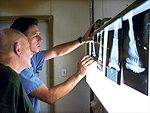Advertise Follow Us
Articles Tagged with ''MRI''
Farrier and veterinarian Scott Pleasant discusses common causes and ways to recognize navicular disease
Read More
Research Journal: May/June 2016
The information, ideas and opinions expressed are those of the author and do not necessarily represent those of the United States Department of Agriculture.
Read More
Research Journal March 2016
The information, ideas and opinions expressed are those of the author and do not necessarily represent those of the United States Department of Agriculture.
Read More
A Firm Grasp of “Normal” Helps Find True Hoof Ailments
A stepwise approach guides farriers and vets in treatment of ailing feet
Read More
Using Diagnostic Imaging to Pinpoint Foot Problems
The vital information that technology can provide is another reason for farriers to work closely with veterinarians
Read More









